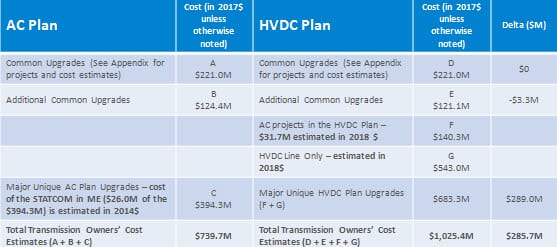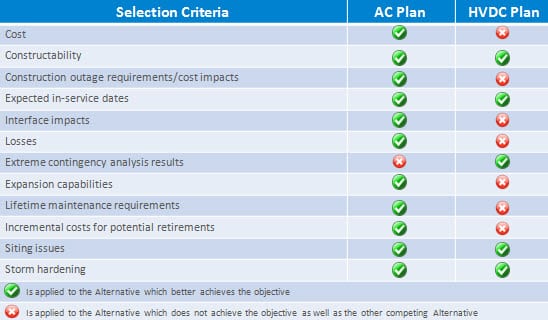ISO-NE selects all-AC transmission solution to address grid reliability needs in Greater Boston

ISO New England has selected the Eversource (formerly Northeast Utilities) and National Grid alternating current (AC) transmission proposal as the preferred transmission solution to bolster the region’s power grid in the Greater Boston area to ensure continued reliability into the future. The all-AC proposal was chosen over another proposal supported by New Hampshire Transmission (NHT), which included the use of both AC and underwater, high-voltage direct current (HVDC) components. The AC plan was ultimately selected because it is significantly less expensive and also because it is superior when other performance criteria are considered.
“Greater Boston is the largest area of consumer demand on New England’s power system, and its transmission system is in critical need of an upgrade,” said Stephen Rourke, Vice President, System Planning of ISO New England Inc. “The ISO has been studying this part of the grid since 2008. As part of its robust review process, the ISO agreed to evaluate an HVDC project proposed by NHT in 2012 against an AC project supported by Eversource and National Grid to determine the most cost-effective solution. Several years later and after exhaustive review, we are confident that the AC project is the right one to address reliability needs in Greater Boston.
“With all engineering reviews and system planning analyses now finalized, it is imperative that the Greater Boston area transmission project moves forward,” Rourke added. “Without these upgrades in place in the near future, power system reliability in Boston may suffer.”
|
New England Transmission Investment From 2002 through 2014, more than 550 transmission projects to address reliability needs have been put into service in the region. These upgrades have strengthened the overall system and made it more resilient and reliable. Because of these transmission upgrades, the region’s grid now has less congestion and enables power to flow more easily around the entire region, which results in decreased wholesale energy costs and increased power system flexibility. Because newer, cleaner, and more efficient plants cost less to operate and power can move to where it is needed more efficiently, the region can rely less on older, less efficient plants for its day-to-day electricity needs. These transmission upgrades have resulted in the termination of special reliability contracts for older, less-efficient plants that at one point exceeded over $700 million per year. By contrast, these transmission projects represent about a $7 billion investment in transmission infrastructure, which is amortized over several decades. |
Robust New England planning process
ISO New England is the independent, not-for-profit entity designated by the Federal Energy Regulatory Commission to conduct power system planning in New England to ensure a reliable power grid. As part of this responsibility, the ISO conducts comprehensive and ongoing engineering studies of areas of the grid to assess where and when upgrades are needed. These studies look at projected growth in demand and confirmed resource additions and retirements, and then evaluate how the system operates under a variety of simulated contingency scenarios such as generator and transmission line outages.
The process culminates each year in a Regional System Plan—a document that looks out 10 years into the future and acts as a blueprint for what’s needed on the regional transmission system to meet federal and regional reliability standards and keep the lights on. The planning process is an open forum that includes input from all sectors of the industry, including government regulators and representatives from the six New England states.
Once a reliability need is identified for a certain area of the grid, the ISO works with transmission owners serving the affected area to arrive at the most cost-effective reliability solution. This iterative process begins with the ISO and transmission owners developing several alternative solutions, looking at system needs as a whole. The ISO then compares all the alternatives and makes modifications to the different alternatives as needed until the most cost-effective proposal that meets the needs is identified. Based on its assessment, the ISO then selects the regionally preferred solution. Once a preferred solution is announced, the transmission owners are responsible for pursuing needed approvals for siting, construction, and, ultimately, building the line or other transmission upgrade.
As an independent organization with no financial stake in any proposed project, the ISO can review and evaluate all proposals and alternatives objectively to select the most cost-effective, reliable transmission solution to meet an identified reliability need.
The cost of transmission projects needed for reliability is regionalized across the six states. Ratepayers in each New England state pay a portion of the cost of each reliability project, based on their state’s share of total regional power usage, regardless of where the project is located, because New England’s power grid is tightly interconnected and reliability upgrades benefit all six states.
Greater Boston transmission system needs: analysis timeline
ISO New England and transmission owners began studying the power system in the Greater Boston area in 2008, and in December 2009, the ISO made its first presentation outlining a number of reliability concerns, such as thermal overloads and high- and low-voltage conditions that would occur under a variety of peak load and contingency situations.
The ISO and the Greater Boston Working Group then worked to develop multiple alternatives to address the reliability problems in the area. Several upgrades, including line reconductorings (replacing existing wires with new, larger wires that can transport more power), were advanced to ensure reliability could be maintained after the retirement of all four Salem Harbor generating units—two in 2011 and two in 2014.
After evaluating the alternatives, the working group presented a set of preferred solutions to address remaining reliability concerns to the Planning Advisory Committee (PAC) in March, 2012. The solutions consisted of AC upgrades, primarily new 345 kilovolt (kV) and 115 kV lines into and within the areas served by Eversource and National Grid. At the same meeting, NHT proposed an HVDC undersea concept also be considered to address the reliability needs. Although the use of HVDC had previously been reviewed and ruled out by the ISO because it was deemed too costly, and several years of work to develop and arrive at a preferred solution was already completed, the ISO agreed to stakeholders’ requests to postpone the decision and evaluate NHT’s proposal.
In 2013, the ISO updated its original needs assessment to reflect several major system changes, including resource additions and retirements, changes in underground cable ratings in Boston, and updated load forecasts. The updated study findings were comparable to the findings of the initial study, showing concerns with the system’s ability to reliably move power into and within the Greater Boston area.
In the meantime, ISO planning engineers spent several years working extensively with NHT to help develop its plan from a conceptual proposal into a technically workable solution. The ISO also worked with Eversource and National Grid to update components of the AC project based on the findings of the 2013 needs assessment. Updated versions of both plans were presented to the PAC in June, 2014.
In addition, because of pressing reliability concerns, several upgrades generally consisting of 115 kV line reconductorings were presented and advanced at previous PAC meetings.
Overview of AC and HVDC plans and costs
A common set of costs
A set of upgrades common to both plans include the reconductoring of several 115 kV lines and other substation and transmission equipment upgrades, which are currently estimated to cost $221 million (not including a few cost estimates for components that have yet to be submitted). Both plans also include upgrades to the Mystic and Woburn substations, though the costs are not identical because of differences in equipment requirements. For the AC plan, those upgrades are estimated at $124.4 million; for the HVDC plan, the needed upgrades are $121.1 million.
Eversource/National Grid AC plan
The components unique to the all-AC project include two new 345 kV transmission lines—one overhead and one underground—as well as the reconductoring of several 115 kV transmission lines, and other substation and transmission equipment upgrades. The project also requires voltage support equipment to be located in Maine. The estimated AC project cost is $394.3 million.
New Hampshire Transmission HVDC plan
The HVDC proposal includes a new 520 MW HVDC undersea cable that originates at a substation in Seabrook, New Hampshire, and travels underwater off the coast of Massachusetts, finally connecting on land to the Mystic substation in Everett, Massachusetts. The project also has unique AC components, which include the reconductoring of a 345 kV line and a 115 kV line, and other substation and transmission equipment upgrades. The estimated HVDC project cost is $683.3 million.
These estimates were submitted to the ISO by the transmission owners. Adding the cost of common upgrades to each proposal, the AC plan is estimated to cost $739.7 million, while the HVDC plan is estimated to cost $1.0254 billion.
To help ensure the reasonableness of the information submitted by the transmission owners, the ISO retained Electrical Consultants, Inc. (ECI), an independent third-party consultant, to examine both proposals and review the cost estimates made by each of the parties. The consultant’s review found the estimates provided for both the AC and HVDC proposals to be reasonable.
Transmission Owners’ Cost Estimates

Thorough review of both projects and their reliability benefits
The ISO has spent several years working with Eversource, National Grid, and NHT to develop technically feasible, “constructable” plans—both of which could address the reliability needs in the Greater Boston area. However, after a thorough analysis of the components of each project, the ISO has determined the all-AC solution is the better choice for the region, not only because it is significantly less expensive, but also because of the physical characteristics of the all-AC plan, which make it superior.
ISO New England adheres to a wide range of transmission planning standards and criteria when evaluating system needs and developing solutions. Ultimately, the ISO is bound by its tariff to identify and select the most cost-effective solution when a reliability need is identified. The ISO also considers broad stakeholder input and the study process is always open to serious evaluation of innovative solutions.
When a significant cost gap exists between proposed alternatives that both can address the identified reliability needs, the ISO will usually select the project with the lowest cost estimate. But when there are multiple alternatives that are similar in cost, the ISO conducts a “performance comparison,” analyzing additional factors, which could include:
- Constructability
- Construction outage requirements/cost impacts
- Expected in-service dates
- Interface impacts
- Transmission losses
- Extreme contingency analysis
- Expansion capabilities
- Lifetime maintenance requirements
- Incremental costs for potential retirements
- Siting issues
- Storm hardening, and
- Operational performance
(See the Transmission Planning Process Guide for additional information.)
Although the costs of the two proposals were not comparable, the ISO evaluated both the AC plan and the HVDC plan based on these additional criteria to give stakeholders a complete comparison and a comprehensive evaluation.
Comparison based on these factors revealed that the AC plan is a better choice overall than the HVDC plan, because it has: fewer losses; better expansion capability; better lifetime maintenance requirements; and fewer incremental costs associated with potential generator retirements, among other criteria. (For more details, please see slides 31 – 50 of the ISO’s Greater Boston Preferred Solution presentation.)
Selection of the Preferred Solution Alternative – Summary

Next Steps
With a preferred solution finalized, Eversource and National Grid are expected to move forward with their siting and construction processes. It is urgent that these upgrades go through the siting and construction process in a timely manner—because without these upgrades, the Greater Boston area faces increasing risks to grid reliability. The year of need for certain components of the Greater Boston Reliability Project was pre-2013. The ISO is analyzing whether additional special operating plans need to be developed to be able to manage the system in Greater Boston during peak load conditions and through various contingencies until the necessary transmission upgrades are placed in service. These special operating plans could include the temporary reconfiguration of certain elements of the transmission system to prevent equipment overloads under certain system conditions, which could reduce reliability in some areas. These plans may also include—in addition to existing operating procedures—other steps that system operators could take in the event of extremely stressed system conditions to protect overall system reliability, up to and including the use of controlled power outages in the Greater Boston area.
- Categories
- Inside ISO New England
- Tags
- planning advisory committee, transmission planning
